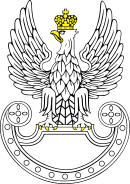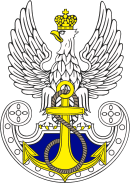Battle of Khotyn (1673)
The Battle of Khotyn or Battle of Chocim or Hotin War[4] was a battle held on 11 November 1673, where Polish-Lithuanian Commonwealth forces under hetman John Sobieski defeated Ottoman Empire forces under Hussain Pasha. It reversed the fortunes of the previous year, when Commonwealth weakness led to the signing of the Treaty of Buchach, and allowed John Sobieski to win the upcoming royal election and become the king of Poland.
Polish-Lithuanian forces and Wallachian regiments were 30 thousand strong. The Turks commanded 35 thousand troops and 120 guns. In this battle rockets of Kazimierz Siemienowicz were deployed successfully. The victory allowed the Poles to revoke the unfavourable Peace of Buchach and set the stage for the role Sobieski was to play in the Battle of Vienna in 1683.
Name
Khotyn (Polish: Chocim; Romanian: Hotin; Turkish: Hotin; Ukrainian: Хоти́н, romanized: Khotyn) was conquered and controlled by many states, resulting in many name changes. Other name variations include Chotyn, or Choczim (especially in Polish).
Aftermath
The Turkish forces withdrew from Poland after their supplies and most of their artillery were captured. Sobieski and the nobles returned to Warsaw for elections following the death of Michael Wisniowiecki, King of Poland, the day before the battle.
Bibliography
- Alan Palmer, The Decline and Fall of the Ottoman Empire, Published by Barnes & Noble Publishing, 1992. ISBN 1-56619-847-X.
- Winged Hussars, Radoslaw Sikora, Bartosz Musialowicz, BUM Magazine, 2016.
References
- Marek Wagner, Wojna polsko-turecka w latach 1672-1676 t.1, Infort Editions, Zabrze 2009, p 376, ISBN 978-83-89943-34-7
- Marek Wagner, Wojna polsko-turecka w latach 1672-1676 t.1, Infort Editions, Zabrze 2009, p 374, ISBN 978-83-89943-34-7
- Marek Wagner, Wojna polsko-turecka w latach 1672-1676 t.1, Infort Editions, Zabrze 2009, p 392, ISBN 978-83-89943-34-7
- DeVries, Kelly Robert (1 May 2014). "The European tributary states of the Ottoman Empire in the sixteenth and seventeenth centuries". Choice. 51 (09): 51–5179. doi:10.5860/CHOICE.51-5179. ISSN 0009-4978.



